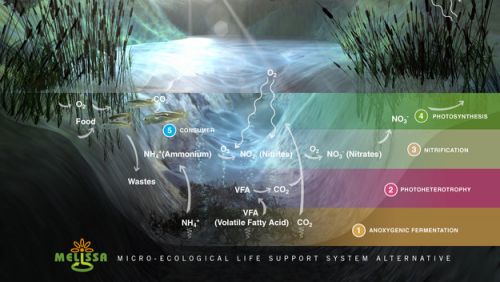
03/09/2015
Travelling to Mars Is In Progress Near the Barcelona Synchrotron Park
Travelling to Mars Is In Progress Near the Barcelona Synchrotron Park
Recently, an original experiment carried out on the International Space Station was exposed by the media: astronauts tested in August the first vegetable ever cultivated into space (a salad) as part of a NASA experiment to help prolong manned missions.
Some hundred meters horizontally far from the Barcelona Synchrotron Park (BSP) - and not 400 km above it -, the MELiSSA pilot plant from the European Space Agency (ESA), which is located in the engineering school of the Universitat Autònoma de Barcelona (UAB), the BSP strategic partner, works on a similar but much more ambitious project.
During a round-trip voyage to Mars, a six-person crew would need about 30 tons of food, oxygen and water for the 1,000 days mission. This huge quantity would be drastically reduced if a closed loop system would recycle the CO2 exhaled and the waste produced by the crew in order to produce in return oxygen, water and food, etc.: this is the MELiSSA project.
This project started 20 years ago and is founded up to 60% by the ESA (5 million Euros per year). It involves 100 researchers from 30 organizations and 15 European countries. In this puzzle the UAB pilot plant, which was inaugurated in 2009, plays a central role and will soon take a new important step: living beings will be introduced in the plant in order to test some parts of the artificial ecosystem. Rats, not astronauts, at the moment.
http://www.esa.int/Our_Activities/Space_Engineering_Technology/Melissa
Some hundred meters horizontally far from the Barcelona Synchrotron Park (BSP) - and not 400 km above it -, the MELiSSA pilot plant from the European Space Agency (ESA), which is located in the engineering school of the Universitat Autònoma de Barcelona (UAB), the BSP strategic partner, works on a similar but much more ambitious project.
During a round-trip voyage to Mars, a six-person crew would need about 30 tons of food, oxygen and water for the 1,000 days mission. This huge quantity would be drastically reduced if a closed loop system would recycle the CO2 exhaled and the waste produced by the crew in order to produce in return oxygen, water and food, etc.: this is the MELiSSA project.
This project started 20 years ago and is founded up to 60% by the ESA (5 million Euros per year). It involves 100 researchers from 30 organizations and 15 European countries. In this puzzle the UAB pilot plant, which was inaugurated in 2009, plays a central role and will soon take a new important step: living beings will be introduced in the plant in order to test some parts of the artificial ecosystem. Rats, not astronauts, at the moment.
http://www.esa.int/Our_Activities/Space_Engineering_Technology/Melissa
More news
28/01/2021
Institutional visit to the Elena Renewable Gas Plant in Parc de l'Alba
12/01/2021
2021: the Alba synchrotron begins its mutation
30/12/2020
The Park has a new Urban Development Master Plan
29/11/2020
The director of Parc de l'Alba, Pere Solà, academic director of the new Postgraduate Course in Urban Planning and Health at the UPC School
18/11/2020
Catalan minister Ramon Tremosa visits the ALBA synchrotron and announces the creation of a public-private investment fund to improve knowledge transfer
03/11/2020
Catalonia, at the forefront of Europe in life sciences and health; the Alba synchrotron contributes to this leadership









